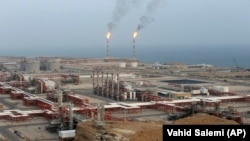Following Iran’s warning about a potential natural gas shortage during the winter months, Iraq's power output has substantially decreased, due to a sharp drop in gas exports from Iran.
"A sharp drop in natural gas imports from Iran within the past three months is the cause behind the decline of electricity production in Iraq," a spokesman for Iraq's electricity ministry, Ahmad Moussa, said on Friday, January 17, in Baghdad.
"Iraq's electricity production, excluding the Kurdish area in the north of the country, shows a 27% drop," Moussa reiterated.
Iranian officials have been boasting that in recent months five new gas production platforms have come on line in South Pars fields in the Persian Gulf, which would mean nearly a 10 percent boost to the country’s gas supplies.
But these claims seem not to be true as a domestic crunch during this winter and a shrap reduction to exports to Iraq indicate.
Based on a contract, the Islamic Republic of Iran is committed to export fifty million cubic meters (approximately 1.8 billion cubic feet) of natural gas per day to Iraq.
Nevertheless, even during the warmer seasons of the year, Iran only exported half of the amount, and even much less in last fall and winter.
"Iran used to export 25 million cubic meters (approximately 883 million cubic feet) of natural gas per day to Iraq, but the amount has dropped to four million cubic meters in recent months," Moussa told Bloomberg.
Following the decline, Iraq's electricity production has dropped from over 19,000 to below 14,000 Megawatts.
Two pipelines laid between Iran and Iraq over the past seven years have failed to deliver as much gas as their combined capacity of 75 million cubic meters a day. At their peak, deliveries reached 27 million, Bloomberg reported.
Earlier on November 11, 2019, Iraq's Undersecretary of the Ministry of Electricity, Abbas Jabr, had maintained that Iraq has three years to achieve the self-sufficiency of electricity.
On the other hand, National Iranian Gas Company (NIGC) announced on January 12 that home and industrial natural gas consumption in the country has set a record, passing 573 million cubic meters per day.
Based on the current rate, Iran would be forced to limit delivering natural gas to its power and industrial sectors.
In the meantime, NIGC has recently stopped publishing monthly data concerning the production and consumption of natural gas in Iran.
Nonetheless, the Islamic authorities have repeatedly boasted in the past year that natural gas production has significantly increased in the country.
However, such claims have never been supported by facts and figures.
For example, the NIGC's dispatching director, Mehdi Jamshidi, maintained on November 20 that the total amount of natural gas consumption in Iran had reached 693 million cubic meters. But the figure given was exactly the same as the one published in the previous year, indicating no real increase.
Therefore, one might argue, if the Islamic Republic authorities' claims about operating five phases of Southern Pars Gas Field were true, there should have been no problem for Iran to fulfill its commitments in exporting its product to Iraq and Turkey.
Furthermore, the decline is not limited to exporting natural gas to Iraq. As a matter of fact, the amount of natural gas delivered to local industrial complexes and power stations has also dramatically dropped.
And while the country's natural gas production has sharply declined, the Islamic Republic government has raised the share of selling the product up to four billion dollars in the next Iranian fiscal year (beginning March 21, 2020) which is 17% more than the previous year.
Iran holds some of the world's largest deposits of proved oil and natural gas reserves, ranking as the world's fourth-largest and second-largest reserve holder of oil and natural gas, respectively. Iran also ranks among the world's top ten oil producers and the top five natural gas producers.








